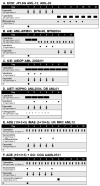Risk-Stratified Therapy for Pediatric Acute Myeloid Leukemia
- PMID: 37627199
- PMCID: PMC10452723
- DOI: 10.3390/cancers15164171
Risk-Stratified Therapy for Pediatric Acute Myeloid Leukemia
Abstract
Acute Myeloid Leukemia (AML) is the second most common type of leukemia in children. Recent advances in high-resolution genomic profiling techniques have uncovered the mutational landscape of pediatric AML as distinct from adult AML. Overall survival rates of children with AML have dramatically improved in the past 40 years, currently reaching 70% to 80% in developed countries. This was accomplished by the intensification of conventional chemotherapy, improvement in risk stratification using leukemia-specific cytogenetics/molecular genetics and measurable residual disease, appropriate use of allogeneic hematopoietic stem cell transplantation, and improvement in supportive care. However, the principle therapeutic approach for pediatric AML has not changed substantially for decades and improvement in event-free survival is rather modest. Further refinements in risk stratification and the introduction of emerging novel therapies to contemporary therapy, through international collaboration, would be key solutions for further improvements in outcomes.
Keywords: acute myeloid leukemia; chemotherapy; children; cytogenetics; hematopoietic stem cell transplantation; measurable residual disease; molecular genetics; novel therapy.
Conflict of interest statement
The authors declare no conflict of interest.
Figures
Similar articles
-
Pediatric acute myeloid leukemia: Insight into genetic landscape and novel targeted approaches.Biochem Pharmacol. 2023 Sep;215:115705. doi: 10.1016/j.bcp.2023.115705. Epub 2023 Jul 31. Biochem Pharmacol. 2023. PMID: 37532055 Review.
-
Pediatric acute myeloid leukemia: updates on biology, risk stratification, and therapy.Curr Opin Pediatr. 2020 Feb;32(1):57-66. doi: 10.1097/MOP.0000000000000855. Curr Opin Pediatr. 2020. PMID: 31815781 Review.
-
The role of matched sibling donor allogeneic stem cell transplantation in pediatric high-risk acute myeloid leukemia: results from the AML-BFM 98 study.Haematologica. 2012 Jan;97(1):21-9. doi: 10.3324/haematol.2011.051714. Epub 2011 Sep 20. Haematologica. 2012. PMID: 21933851 Free PMC article. Clinical Trial.
-
[Acute leukemia in adults].Pathologe. 2015 Sep;36(5):503-17; quiz 518-9. doi: 10.1007/s00292-015-0087-y. Pathologe. 2015. PMID: 26314268 Review. German.
-
Treatment of acute myeloid leukemia in children: A practical perspective.Pediatr Blood Cancer. 2021 Jul;68(7):e28979. doi: 10.1002/pbc.28979. Epub 2021 Apr 12. Pediatr Blood Cancer. 2021. PMID: 33844444 Review.
Cited by
-
Clinical practice guidelines for molecular tumor marker, 2nd edition review part 2.Int J Clin Oncol. 2024 May;29(5):512-534. doi: 10.1007/s10147-024-02497-0. Epub 2024 Mar 17. Int J Clin Oncol. 2024. PMID: 38493447
-
Intensive chemotherapy with dual induction and ALL-like consolidation for childhood acute myeloid leukemia: a respective report from multiple centers in China.Ther Adv Hematol. 2024 May 31;15:20406207241256894. doi: 10.1177/20406207241256894. eCollection 2024. Ther Adv Hematol. 2024. PMID: 38828002 Free PMC article.
-
The efficacy of homoharringtonine in pediatric acute myeloid leukemia: findings from the Chinese Children's Leukemia Group-AML 2015 Study.Transl Pediatr. 2024 Feb 29;13(2):376-379. doi: 10.21037/tp-23-536. Epub 2024 Feb 23. Transl Pediatr. 2024. PMID: 38455741 Free PMC article. No abstract available.
-
Unveiling unexpected adverse events: post-marketing safety surveillance of gilteritinib and midostaurin from the FDA Adverse Event Reporting database.Ther Adv Drug Saf. 2025 Jan 10;16:20420986241308089. doi: 10.1177/20420986241308089. eCollection 2025. Ther Adv Drug Saf. 2025. PMID: 39802043 Free PMC article.
-
Prognostic factors and outcomes in pediatric acute myeloid leukemia: a comprehensive bibliometric analysis of global research trends.Front Oncol. 2025 Feb 17;15:1466818. doi: 10.3389/fonc.2025.1466818. eCollection 2025. Front Oncol. 2025. PMID: 40034590 Free PMC article.
References
-
- Creutzig U., van den Heuvel-Eibrink M.M., Gibson B., Dworzak M.N., Adachi S., de Bont E., Harbott J., Hasle H., Johnston D., Kinoshita A., et al. Diagnosis and management of acute myeloid leukemia in children and adolescents: Recommendations from an international expert panel. Blood. 2012;120:3187–3205. doi: 10.1182/blood-2012-03-362608. - DOI - PubMed
-
- Khoury J.D., Solary E., Abla O., Akkari Y., Alaggio R., Apperley J.F., Bejar R., Berti E., Busque L., Chan J.K.C., et al. The 5th edition of the World Health Organization Classification of Haematolymphoid Tumours: Myeloid and Histiocytic/Dendritic Neoplasms. Leukemia. 2022;36:1703–1719. doi: 10.1038/s41375-022-01613-1. - DOI - PMC - PubMed
-
- Pfister S.M., Reyes-Múgica M., Chan J.K., Hasle H., Lazar A.J., Rossi S., Ferrari A., Jarzembowski J.A., Pritchard-Jones K., Hill D.A., et al. A Summary of the Inaugural WHO Classification of Pediatric Tumors: Transitioning from the Optical into the Molecular Era. Cancer Discov. 2022;12:331–355. doi: 10.1158/2159-8290.CD-21-1094. - DOI - PMC - PubMed
-
- Arber D.A., Orazi A., Hasserjian R.P., Borowitz M.J., Calvo K.R., Kvasnicka H.-M., Wang S.A., Bagg A., Barbui T., Branford S., et al. International Consensus Classification of Myeloid Neoplasms and Acute Leukemias: Integrating morphologic, clinical, and genomic data. Blood. 2022;140:1200–1228. doi: 10.1182/blood.2022015850. - DOI - PMC - PubMed
-
- Bolouri H., Farrar J.E., Triche T., Jr., Ries R.E., Lim E.L., Alonzo T.A., Ma Y., Moore R., Mungall A.J., Marra M.A., et al. The molecular landscape of pediatric acute myeloid leukemia reveals recurrent structural alterations and age-specific mutational interactions. Nat. Med. 2018;24:103–112. doi: 10.1038/nm.4439. - DOI - PMC - PubMed
Publication types
Grants and funding
LinkOut - more resources
Full Text Sources
Miscellaneous



